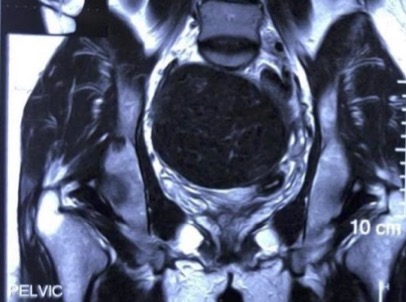Rudimentary Horn Adenomyosis in A 20-Year-Old Patient With Unicornuate Uterus: A Case Report
DOI:
https://doi.org/10.38179/ijcr.v3i1.87Keywords:
Adenomyosis, laparoscopy, mullerian anomalies, rudimentary horn, unicornuate uterusAbstract
Background: A unicornuate uterus with a rudimentary horn is a rare Mullerian anomaly with few cases reported in the literature. The symptoms vary depending on the functionality of the endometrial cavity and the presence of an obstruction. Adenomyosis is a disease defined as areas of endometrial glands and stroma present within the myometrium. Reports describing adenomyosis in relation to the Mullerian anomalies are scarce.
Case Report: We present a 20-year-old middle eastern woman admitted for chronic pelvic pain and abdominal distension. Pelvic ultrasound revealed a unicornuate uterus with an adjacent mass of 10 x 8 cm. An MRI (Magnetic Resonance Imaging) was performed, and a left unicornuate uterus was demonstrated. On the right side, a large non-communicating rudimentary horn with features suggesting diffuse adenomyosis was found. Laparoscopic removal of the horn was performed successfully, and the extraction of the specimen was made by a power morcellation containment system. The patient was discharged uneventfully the second day after the surgery, and the pathology result confirmed the presence of diffuse adenomyosis.
Conclusion: Non-communicating rudimentary horn is a rare finding manifesting as different symptoms in young women. The enlargement of the horn can have obstructive consequences on an active endometrium, and this would lead to the formation of a hematometra and the distension of the cavity, and sometimes adenomyosis.
References
Arab M, Mehdighalb S, Khosravi D. Functional rudimentary horn as a rare cause of pelvic pain: A case report. Iran Red Crescent Med J. 2014;16(11). https://www.ncbi.nlm.nih.gov/pmc/articles/PMC4329928/. Accessed Mar 16, 2021. 10.5812/ircmj.19351. PMID: 25763218. https://doi.org/10.5812/ircmj.19351
Chan YY, Jayaprakasan K, Zamora J, Thornton JG, Raine-Fenning N, Coomarasamy A. The prevalence of congenital uterine anomalies in unselected and high-risk populations: A systematic review. Hum Reprod Update. 2011;17(6):761-771. Accessed Mar 16, 2021. PMID: 21705770. https://doi.org/10.1093/humupd/dmr028
Sleiman Z, Zreik T, Bitar R, Sheaib R, Al Bederi A, Tanos V. Uncommon presentations of an uncommon entity: OHVIRA syndrome with hematosalpinx and pyocolpos. Facts Views Vis Obgyn. 2017;9(3):167-170. Accessed Mar 16, 2021. PMID: 29479403
Garcia L, Isaacson K. Adenomyosis: Review of the literature. J Minim Invasive Gynecol. 2011;18(4):428-437. Accessed Mar 16, 2021. PMID: 21622029. https://doi.org/10.1016/j.jmig.2011.04.004
Trabert B, PhD, Weiss, Noel S., MD, DrPH, Rudra CB, PhD, Scholes D, PhD, Holt VL, PhD. A case-control investigation of adenomyosis: Impact of control group selection on risk fac-tor strength. Women's health issues. 2011;21(2):160-164. https://www.clinicalkey.es/playcontent/1-s2.0-S104938671000126X. https://doi.org/10.1016/j.whi.2010.09.005
Yu O, Schulze-Rath R, Grafton J, Hansen K, Scholes D, Reed SD. Adenomyosis incidence, prevalence and treatment: United states population-based study 2006-2015. Am J Obstet Gynecol. 2020;223(1):94.e1-94.e10. Accessed Mar 16, 2021. https://doi.org/10.1016/j.ajog.2020.01.016
Struble J, MD, Reid S, MD, Bedaiwy, Mohamed A., MD, PhD. Adenomyosis: A clinical re-view of a challenging Gynecologic Condition. Journal of minimally invasive gynecology. 2016;23(2):164-185. https://www.clinicalkey.es/playcontent/1-s2.0-S1553465015015599. https://doi.org/10.1016/j.jmig.2015.09.018
Engmann L, Schmidt D, Nulsen J, Maier D, Benadiva C. An unusual anatomic variation of a unicornuate uterus with normal external uterine morphology. Fertil Steril. 2004;82(4):950-953. Accessed Mar 16, 2021. PMID: 15482778. https://doi.org/10.1016/j.fertnstert.2004.03.043
Buttram VC, Gibbons WE. Müllerian anomalies: A proposed classification. (an analysis of 144 cases). Fertil Steril. 1979;32(1):40-46. Accessed Mar 16, 2021. PMID: 456629. https://doi.org/10.1016/s0015-0282(16)44114-2
Khati NJ, Frazier AA, Brindle KA. The unicornuate uterus and its variants. Journal of Ultrasound in Medicine. 2012;31(2):319-331. https://onlinelibrary.wiley.com/doi/abs/10.7863/jum.2012.31.2.319. Accessed Mar 16, 2021. doi: https://doi.org/10.7863/jum.2012.31.2.319.
Takeuchi K, Tateiwa H, Hamana S, Yoshida S, Kitazawa S, Maruo T. Invasive adenocar-cinoma arising from adenomyosis in a septate uterus. Acta Obstet Gynecol Scand. 2006;85(9):1146-1147. Accessed Mar 16, 2021. https://doi.org/10.1111/j.1048-891X.2004.14541.x
Al-Fadhli R, Tulandi T. A rare case of completely separated rudimentary uterine horns with myoma and adenomyosis. Journal of Minimally Invasive Gynecology. 2006;13(2):86-87. https://www.jmig.org/article/S1553-4650(05)01116-7/abstract. Accessed Mar 16, 2021. doi: 10.1016/j.jmig.2005.10.004. PMID: 16527707. https://doi.org/10.1016/j.jmig.2005.10.004
Su H, Chen C, Gao H, Liu J. A bicornuate uterus with a unilateral cornual adenomyo-sis. Obstet Gynecol. 2005;105(5 Pt 2):1191-1193. Accessed Mar 16, 2021. PMID: 15863577. https://doi.org/10.1097/01.AOG.0000147838.04119.bd
Al-Safi ZA, Russ PD, Post MD, Polotsky AJ. Adenomyosis within a uterine septum in a patient with secondary infertility. Gynecol Endocrinol. 2013;29(8):804-806. Accessed Mar 16, 2021. PMID: 23741967. https://doi.org/10.3109/09513590.2013.801445
Grimbizis GF, Gordts S, Di Spiezio Sardo A, et al. The ESHRE-ESGE consensus on the classification of female genital tract congenital anomalies. Gynecol Surg. 2013;10(3):199-212. Accessed Sep 29, 2021. PMID: 23771171. https://doi.org/10.1093/humrep/det098
Guo S. The pathogenesis of adenomyosis vis-à-vis endometriosis. J Clin Med. 2020;9(2). Accessed Mar 16, 2021. PMID: 32050720. https://doi.org/10.3390/jcm9020485
Kıykaç Altınbaş Ş, Tapısız ÖL, Ünsal M, Moraloğlu Tekin Ö. Laparoscopic hemi-hysterectomy in a noncommunicating uterine horn: The critical steps to be consid-ered. Turk J Obstet Gynecol. 2020;17(2):143-145. https://www.ncbi.nlm.nih.gov/pmc/articles/PMC7406904/. Accessed Mar 16, 2021. PMID: 32850191. https://doi.org/10.4274/tjod.galenos.2020.01709

Published
How to Cite
Issue
Section
Copyright (c) 2022 International Journal of Clinical Research

This work is licensed under a Creative Commons Attribution 4.0 International License.







